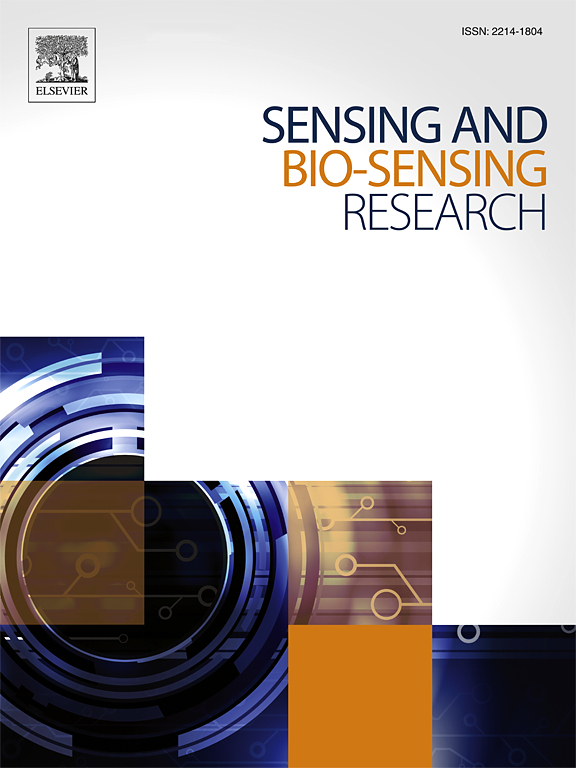多标记策略提高直接适体传感器检测MUC1肿瘤标志物的灵敏度
IF 4.9
Q1 CHEMISTRY, ANALYTICAL
引用次数: 0
摘要
适配体在即时诊断(POC)方面具有巨大潜力,但传感器结构的复杂性和检测小分子的低灵敏度仍然具有挑战性。在这项研究中,我们提出了一种简单而有效的方法来提高电化学ap-tamer (E-AB)传感器的灵敏度。该适体通过赖氨酸连接体用双氧化还原标签进行标记,并与优化长度的钝化层结合,从而增强了增益,从而提高了灵敏度。测定了该E-AB传感器的分析性能,并与常规E-AB传感器对缓冲液和血清MUC1的检测进行了比较。我们的研究表明,具有赖氨酸连接体的双标记适体具有优异的性能,在缓冲液中MUC1的检测限(LOD)低至2.4 nM,线性耳动态范围(LDR)从5.0 × 101到4.0 × 102 nM。相比之下,传统的对应物显示出10倍高的LOD (25.7 nM)。这种创新的合成策略解决了信噪比(S/N)的限制以及对肿瘤标志物检测的更高灵敏度的需求,这可能为P.O·C检测的快速简单回答技术带来希望。本文章由计算机程序翻译,如有差异,请以英文原文为准。
Multi-labeling strategy to enhance direct aptamer sensor sensitivity for detecting MUC1 tumor marker
Aptamers hold great potential for point-of-care diagnostics (POC), but the complexity of sensor architectures and poor sensitivities in detecting small molecules remain challenging. In this study, we present a simple but effective approach to enhance the sensitivity of the electrochemical ap-tamer-based (E-AB) sensors. The proposed aptamer was labeled by double redox tags through a lysine linker and incorporated with an optimized length of passivation layer, which cooperatively led to gain enhancement and thus higher sensitivity. The analytical performance of this E-AB sen-sor was measured and compared with a conventional E-AB sensor towards the detection of MUC1 in buffer and serum. Our study revealed the double-tagged aptamer with a lysine linker's superior performance, yielding a low 2.4 nM limit of detection (LOD) for MUC1 in buffer, with a wide lin-ear dynamic range (LDR) from 5.0 × 101 to 4.0 × 102 nM. In contrast, the conventional counterpart exhibited a tenfold higher LOD (25.7 nM). This innovative synthetic strategy addresses the limita-tions of the signal-to-noise ratio (S/N) and the need for higher sensitivity towards the detection of the tumor markers, which may hold promise for rapid simple-to-answer technology for P.O·C testing.
求助全文
通过发布文献求助,成功后即可免费获取论文全文。
去求助
来源期刊

Sensing and Bio-Sensing Research
Engineering-Electrical and Electronic Engineering
CiteScore
10.70
自引率
3.80%
发文量
68
审稿时长
87 days
期刊介绍:
Sensing and Bio-Sensing Research is an open access journal dedicated to the research, design, development, and application of bio-sensing and sensing technologies. The editors will accept research papers, reviews, field trials, and validation studies that are of significant relevance. These submissions should describe new concepts, enhance understanding of the field, or offer insights into the practical application, manufacturing, and commercialization of bio-sensing and sensing technologies.
The journal covers a wide range of topics, including sensing principles and mechanisms, new materials development for transducers and recognition components, fabrication technology, and various types of sensors such as optical, electrochemical, mass-sensitive, gas, biosensors, and more. It also includes environmental, process control, and biomedical applications, signal processing, chemometrics, optoelectronic, mechanical, thermal, and magnetic sensors, as well as interface electronics. Additionally, it covers sensor systems and applications, µTAS (Micro Total Analysis Systems), development of solid-state devices for transducing physical signals, and analytical devices incorporating biological materials.
 求助内容:
求助内容: 应助结果提醒方式:
应助结果提醒方式:


